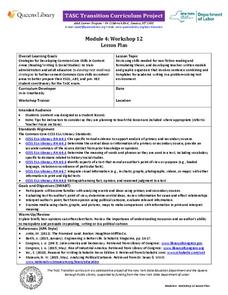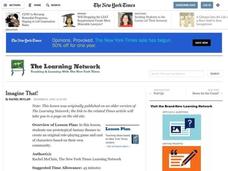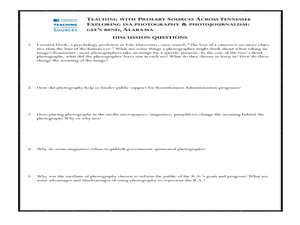EngageNY
TASC Transition Curriculum: Workshop 12
How can opinions slant facts? Workshop participants learn how to examine primary and secondary sources and identify the author's point of view. They also examine how visual art impacts the meaning and rhetoric of sources. Full of...
Reed Novel Studies
The Mostly True Adventures of Homer P. Figg: Novel Study
What was the purpose of the Enrollment Act of 1863? Pupils consider the topic while completing the novel study for The Mostly True Adventures of Homer P. Figg by Rodman Philbrick. They write original similes and answer reading...
Curated OER
Captions and Graphic Aides
Fifth graders read a book. In this informational text features instructional activity, 5th graders define captions and their purpose. Students view an article and discuss the graphic aides that assist comprehending the...
Curated OER
Space Jam Dilemma/Dance
Do the "Space Jam" Dance! A dance that is made up of basketball skills movements, such as: dribbling, defending with hands up, pivoting, shooting, and slam dunks. The dance step descriptions are very well written out with cues for...
Curated OER
Surveying Salinger with Dialogue and Disillusionment
Find creative ways to teach Salinger's stories by focusing on dialogue, cultural context, and characterization.
Curated OER
Imagine That!
Enter the fantastical world of "Dungeons and Dragons" and other role-playing games with this lesson from The New York Times. Middle schoolers create the outline for a role-playing game based on their own community. Then, they...
Curated OER
Boogie Woogie with a B: Using Alliteration while Exploring Patriotic Tunes
Are you looking for a way to bring writing into your history lesson - or history into your writing lesson? This cross-curricular activity is helpful and fun, no matter what class you're teaching! Using "Boogie Woogie Bugle Boy" by the...
Roy Rosenzweig Center for History and New Media
Founding Documents
Teach the class about the predecessor to Declaration of Independence—the Virginia Declaration of Rights. Using the foundational documents, scholars examine the two writings to consider how they are similar and how they are different. A...
EngageNY
Drafting Introduction and Conclusion
In conclusion ... Scholars analyze the model essay Adversity Faced by Townspeople in
the Middle Ages to gain a better understanding of introductory and concluding paragraphs. After studying the author's strategies, learners begin...
Library of Congress
The Story of The Three Little Pigs
Bring the 1904 version of the classic kid's tale, The Story of the Three Little Pigs to your young readers. With original drawings by L. Leslie Brooke, young reader take a step into a world where pigs can talk and a wolf is big and bad.
ReadWriteThink
Biography Project: Research and Class Presentation
I Have A Dream ... that after the lesson, all individuals master the reading, writing, researching, listening, and speaking skills the biography project helps them develop. Martin Luther King, Jr. serves as a topic example for a model...
Curated OER
Teaching with Primary Sources Across Tennessee
Students examine Gee's Bend Alabama. In this resettlement lesson, students view a series of photographs taken of Gee's Bend Alabama. Students will write a series of newspaper articles based on the images, that exemplify the evolution of...
Curated OER
The Lorax Explorations
Students read and debate the purpose of Dr. Seuss' The Lorax, analyze its story elements, and write their own The Lorax II.
Curated OER
The Rumpelstiltskin Story
Why didn't Rapunzel's hair stop growing? Why did it take the fairy godmother so long to intervene in Cinderella's affairs? Young writers consider unanswered questions like these and compose news articles investigating the true...
Curated OER
Rediscovering Forgotten Women Writers
Women's voices are becoming more prominent in the world of literature, but for centuries, this wasn't the case. Young historians research a woman whose writings are considered to be lost, out of print, or forgotten. They develop an oral...
Curated OER
The Facts, Gimme the Facts!
Learners engage in a variety of activities which help them memorize their times tables. There are some very good ideas imbedded in this plan of how to systematically teach the basic facts in a way that help students retain what they learn.
Curated OER
As the Kids Come and Go: Mapping a Classroom
Map the classroom with your kids to help them understand how maps work and how to read them. The lesson starts off with a story about animals living and moving around the globe, and then kids create maps of their classroom to show how...
Curated OER
Hypatia: Angles
Introduce your young geometers to Hypatia, the first noted Greek female mathematician, and the properties of angles. Though this resource is missing worksheets that are needed to complete the lesson, the structure is sound and learning...
Curated OER
Autobiography
Sixth graders read and write autobiographical sketches, determine the author's purpose in writing, and type paragraphs using WP utilities.
Curated OER
Short Story Group PowerPoint Project
Students choose a short story from the class literature book. They find information about the author. They read the short story from the literature textbook. They create a PowerPoint to retell the short story.
Curated OER
For the Fun of It
Middle schoolers investigate author's purpose in autobiography by reading Amelia Earhart's autobiography entitled The Fun of It. Students examine character traits needed to fulfill personal goals.
Curated OER
Using Children's Literature to Teach Writing: No, David!
Students review beginning, middle, and end of a story and how details add to a story.
Curated OER
Teaching Elementary School Social Studies
Students identify possible social studies themes that can come from the video, "Voyage of Discovery". They list the five themes of geography. They develop elementary-level interdisciplinary unit plans for social study content. They...
Ontario
Weekly Lesson Plan for Shared Reading
Reading is fun! Here, practice making predictions and instill concepts of print including the front of the book's features, the text's message, the connection between text and illustrations, and directionality with these daily reading...























